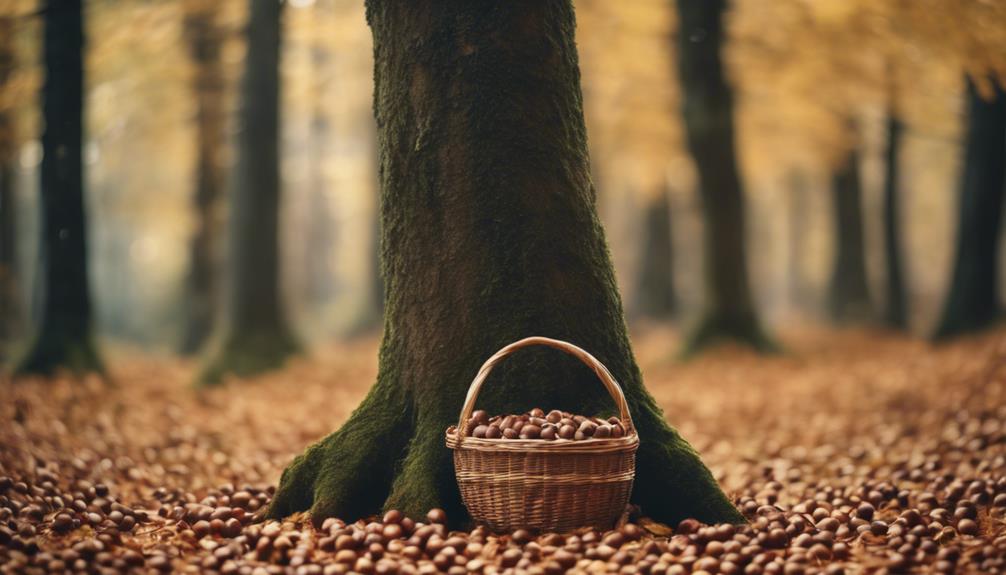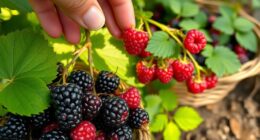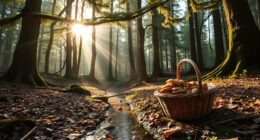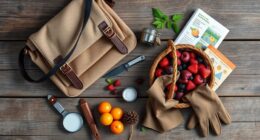Urban food forests are fantastic places where you can enjoy fresh fruits and nuts right in your city! They include trees like apple, pear, and walnut, all good for tasty snacks and healthy meals. These trees help keep our air clean and make our neighborhoods prettier too. Plus, they create homes for birds and bugs, making the city more vibrant. You can learn cool foraging techniques, like how to gather sap from birches or young leaves from maples. So, if you're excited to grow delicious food in your community, get ready to explore more about this amazing adventure!
Key Takeaways
- Common edible trees in urban food forests include apples, pears, mulberries, figs, chestnuts, and walnuts for year-round nutrition.
- Selecting trees should consider local climate, soil conditions, and disease resistance for successful growth and sustainability.
- Incorporating native species enhances biodiversity and supports local wildlife, creating healthier urban ecosystems.
- Ethical foraging practices are essential for sustainability, ensuring minimal impact on urban ecosystems while utilizing tree resources responsibly.
- Community engagement through workshops and activities fosters awareness and promotes the benefits of urban food forests.
Understanding Urban Food Forests

Understanding urban food forests means recognizing how these innovative spaces transform city landscapes into vibrant ecosystems.
You'll find that these food forests blend trees, shrubs, and even some vegetable plants to create beautiful green areas where everyone can gather. By following permaculture principles, these gardens mimic nature, using layers like a canopy, understory, and ground cover to grow a variety of foods in a small space. Additionally, the practice of mindful consumption encourages communities to appreciate the resources they cultivate and consume. Urban food forests can also be a source of adaptogenic properties, contributing to the overall health of the community. Furthermore, these spaces can play a role in combating climate change, as they help to sequester carbon and improve urban air quality. The incorporation of natural elements in these areas enhances the overall ambiance and promotes tranquility.
Urban food forests aren't just about growing tasty treats; they also help your community. They improve access to fresh produce, making it easier for families to enjoy healthy meals.
Plus, these green spaces increase biodiversity, which means more birds and butterflies can thrive in your neighborhood. Think about places like the Beacon Food Forest in Seattle, where community members come together to plant and care for their food forest.
Additionally, urban food forests can serve as tools for enhancing community wellness, contributing to the overall health and vibrational energy of the area.
Benefits of Edible Trees

Edible trees in our cities can really make a difference!
They not only give us tasty fruits and nuts, boosting our nutrition, but also help our local wildlife thrive. Additionally, these trees can provide energy-efficient technology that contributes to a sustainable urban environment. Furthermore, planting these trees can create financial security by minimizing food costs and encouraging local food systems. Moreover, integrating sustainable forestry practices into urban tree planting can further enhance the environmental benefits of these edible trees.
Furthermore, the incorporation of innovative settings can optimize the growth conditions for these trees, ensuring they thrive in urban landscapes.
Plus, these beautiful trees make our neighborhoods look nicer and more inviting, creating a happier place for everyone to enjoy!
Additionally, planting edible trees can enhance community resilience by providing a sustainable food source and promoting local biodiversity.
Nutritional Value Enhancement
Urban food forests transform city landscapes into vibrant sources of nutrition, offering a bounty of edible trees that enhance dietary value. In these urban areas, you can find amazing fruit trees like mulberries and figs. These delicious fruits are packed with vitamins and antioxidants, which help you stay healthy and strong. Additionally, the soluble fiber in fruits like figs can support digestive health and promote regularity. Chia seeds, often incorporated into diets alongside fruits, are also known for their high fiber content, making them excellent for digestive wellness. Furthermore, incorporating dollar-cost averaging strategies into your food budgeting can help you make the most of seasonal fruit availability.
But wait, there's more! Trees like chestnuts and walnuts provide nutritious nuts that are full of healthy fats and protein. Eating these can support your heart health and help you manage your weight.
Did you know that the inner bark of trees like birch and maple can be turned into flour? This flour is high in fiber and great for your tummy!
You can also enjoy young leaves and flowers from trees like linden and maple, which are rich in vitamins A and C. Tapping sugar maple trees for their sap gives you a natural sweetener, plus minerals like calcium and potassium for a balanced diet. Furthermore, incorporating anti-inflammatory foods such as these edible trees can contribute to overall wellness and support pain management.
With all these choices, edible trees are a fantastic way to boost your food's nutritional value while enjoying nature right in your city!
Biodiversity Support Mechanism
The presence of edible trees in city landscapes does more than just enhance nutritional value; it plays an essential role in supporting biodiversity.
When you plant trees like American beech, birch, and mulberry, you're not just adding beauty. You're creating homes and food for wildlife, making urban areas lively ecosystems! Additionally, incorporating native tree species can further enhance habitat diversity and resilience within urban environments. Moreover, integrating self-watering planters can help maintain these trees' health by ensuring they receive consistent moisture, especially in urban settings where water availability may fluctuate. Educational toys can also engage children in understanding these ecosystems, highlighting the significance of biodiversity support mechanisms in their growth. Furthermore, planting these trees can foster unconditional love for nature, promoting a deeper appreciation for the environment and its interconnectedness.
Here are some fantastic benefits of edible trees:
- They support pollinators and helpful insects, keeping the environment balanced.
- Their leafy canopies improve air quality and lower temperatures, making cities cooler and more pleasant.
- They encourage community involvement, helping people connect with nature and understand local ecosystems. Additionally, the integration of educational toys can promote awareness of urban biodiversity among children, fostering a sense of stewardship for these edible trees.
Aesthetic Urban Improvement
When you incorporate trees that bear fruit and nuts into city landscapes, you not only create vibrant visual appeal but also enrich the urban environment in meaningful ways. Edible trees, like the beautiful blossoming cherry or the colorful maple, bring stunning sights to your neighborhood.
Imagine walking down a street lined with lovely trees that not only look good but also taste delicious! These trees boost aesthetic urban improvement and can help increase biodiversity. More birds and butterflies will flutter around, making your city feel like a lively, green oasis. Additionally, many edible trees can provide natural habitats for beneficial insects, contributing to overall ecosystem health. Trees like celery juice can be incorporated into urban gardens, offering additional nutritional benefits to the community.
Plus, trees like chestnuts and hazelnuts don't just provide shade; they also offer nutritious snacks for you and your friends, promoting community health. Incorporating these trees also encourages a sense of self-care and mindfulness, as interacting with nature can greatly enhance emotional well-being.
With edible trees in your town, property values may rise as people love green spaces and beautiful landscapes.
Trees like linden and birch improve air quality and cool down hot summer days, making your city a healthier place to live. Additionally, integrating these trees can lead to greater community health benefits, as access to fresh, nutritious food can enhance overall well-being. Herbal teas, made from some of these trees' leaves and flowers, can further promote health and well-being, offering a delightful way to enjoy the benefits of urban greenery.
Common Edible Tree Species

Let's explore some tasty tree species that you can find in our urban food forests! Trees like the sweet Sugar Maple, the nutty American Beech, and the juicy Mulberry not only look beautiful but also provide delicious treats. Additionally, many urban foragers enjoy incorporating nutritious ingredients like the ones found in traditional African dishes into their cooking, enhancing the flavors of their meals. Choosing the right trees for your urban environment can significantly improve water efficiency and help create a sustainable food source. Establishing these trees can also contribute to improved cash flow management for community-based businesses by providing fresh produce. Furthermore, planting these trees can promote emotional alignment within communities as people come together to cultivate and share resources. You might even consider growing trees that yield high-calorie breakfasts, providing nourishment for the community. You'll love learning how to forage for these edible treasures right in your neighborhood!
Edible Tree Varieties
In urban environments, incorporating edible tree varieties can transform green spaces into sustainable food sources.
Imagine walking through a park and discovering trees that not only provide shade but also yummy treats! With a little knowledge, you can enjoy the benefits of fruit trees and other edible trees right in your neighborhood. AI-Powered Virtual Reality in E-Learning could enhance the learning experience about sustainable urban gardening. Additionally, trees like mulberries can offer health benefits such as boosting immune function due to their rich antioxidant content. Furthermore, planting these trees can contribute to air quality improvement by absorbing carbon dioxide. Furthermore, planting turbocharger installations in urban greenery can significantly enhance food production.
Here are some fantastic edible tree varieties you might find:
- Maple trees: These trees give you sweet sap for syrup, and you can munch on their inner bark, seeds, and young leaves.
- Mulberry trees: Their delicious, sweet fruits are perfect for snacking, and even their twigs are edible!
- Chestnut trees: Known for their tasty nuts, they can easily thrive in city landscapes. Additionally, incorporating natural sweetening alternatives like honey from these trees can enhance your culinary experience.
Foraging Techniques Overview
Foraging for edible tree species can be an exciting way to connect with nature while enhancing your culinary options. As you explore your city, keep an eye on urban trees like maples and birches. These trees offer tasty edible components, such as sap, inner bark, and young leaves, which can be harvested for both nutrition and delicious dishes. Many cities have local foraging groups that can help you identify these trees and their edible parts, making it easier to explore DIY fire pit ideas for a perfect outdoor cooking experience. Engaging in foraging also promotes sustainability and energy independence, as it encourages the use of local resources.
Don't forget about oak trees! Their acorns are universally edible, and with a little processing, you can reduce their bitterness. They make a fantastic survival food option in urban areas.
Pine trees are treasure troves too, providing pine nuts, inner bark, and young needles that can be brewed into a vitamin C-rich tea. Foraging for pine nuts can be particularly rewarding, as they are a key ingredient in many dishes.
Linden trees also have edible young leaves and flowers that are perfect for salads or a fragrant tea. Additionally, incorporating sustainable practices in your foraging efforts ensures that the natural resources remain available for future generations. Always remember to follow ethical foraging guidelines to protect urban ecosystems.
Remember, when using foraging techniques, it's important to practice sustainable practices. Always take only what you need and respect the urban ecosystem. By doing this, you help guarantee that these wonderful trees continue to thrive for years to come.
Foraging Techniques and Safety

When you venture into the world of urban foraging, it's essential to ascertain you can accurately identify the tree species and its edible parts, as many trees have toxic look-alikes.
To keep your foraging fun and safe, here are a few tips to remember:
- Consult a field guide or expert before tasting anything new.
- Harvest sustainably by only taking a small portion, ensuring the tree stays healthy.
- Be aware of your surroundings and avoid places that might've been sprayed with chemicals. Additionally, be mindful of the health benefits of the plants you are foraging, as some may provide nutritional value. Understanding the financial needs of your community can also enhance your foraging experience by highlighting local edible resources. Dogs can also benefit from safe fruits like apples and blueberries, which can be foraged in urban areas.
Foraging techniques work best in certain seasons. For example, spring is perfect for gathering young leaves and seeds from maples, as this time aligns with emotional dysregulation that can affect decision-making.
When you're out there, use gloves and clean tools to protect both yourself and the trees. This not only helps keep everything safe but also prevents contamination. Additionally, it's important to be aware of toxic plants that could pose risks to your health while foraging.
Establishing an Urban Food Forest

Creating an urban food forest can transform a neglected space into a vibrant ecosystem filled with edible trees and plants. To get started, choose a mix of edible tree species, like juicy apples, sweet pears, and crunchy walnuts. This variety guarantees you have delicious treats throughout the year.
In your food forest design, think about layers! Tall canopy trees provide shade, while smaller understory plants thrive below. Ground cover plants help keep the soil healthy and can even be tasty snacks. You can also use companion planting, where certain plants support each other, helping to keep pests away and boost growth.
Don't forget about sustainability! Using local resources, like rainwater harvesting systems, can help you water your forest without wasting.
Plus, getting the community involved is key. Organize fun workshops and invite volunteers to help plant and care for the trees. This builds a sense of ownership and teamwork, guaranteeing your urban food forest flourishes for years to come.
With a little planning and love, you'll create a beautiful space where everyone can enjoy the gifts of nature!
Community Engagement and Education

Engaging the community is essential for the success of an urban food forest, as it brings people together and fosters a deeper connection to the environment. When you participate in community engagement, you help create a space that not only grows food but also grows friendships!
Through fun educational programs, you can learn about foraging and discover the tasty treasures hidden in local trees.
Here are some great ways to get involved:
- Join workshops that teach you about the benefits of foraging and how to identify edible parts of trees.
- Participate in monthly work parties where you can help with gardening tasks and meet your neighbors.
- Explore educational resources like pamphlets and guided tours to learn more about the nutritional value of tree components.
Additionally, understanding the benefits of foraging can inspire more people to join in and appreciate the resources that urban food forests provide.
Working with schools and community organizations can also make a big difference. Together, you can teach kids about biodiversity and food security, which helps promote sustainability.
Sustainability and Environmental Impact

Urban food forests play an essential role in promoting sustainability and enhancing the environment. By planting edible trees in our cities, you help create green spaces that boost biodiversity. These trees provide homes for birds and beneficial insects, making our neighborhoods livelier and healthier. They also clean the air, giving us fresher oxygen to breathe!
When you grow food forests, you're not just planting trees; you're also cooling your city. Trees create shade and help lower temperatures, reducing the urban heat island effect.
Plus, as cities grow, food forests improve food security by giving everyone access to fresh fruits and nuts. This is super important since many people will live in cities by 2030.
Another great thing about food forests is their impact on soil health. The variety of plants reduces the need for harmful chemicals, making the earth healthier. Sustainable farming practices are essential for protecting our planet.
This aligns with sustainable farming practices that protect our planet.
Frequently Asked Questions
What Is the Best Time to Plant Edible Trees in Urban Areas?
The best time to plant edible trees in urban areas is usually in the spring or fall.
During these seasons, the weather's just right—cooler temperatures and plenty of rain help your trees grow strong. You should make sure to plant them when the ground isn't frozen, so the roots can spread easily.
With a little care and patience, you'll soon enjoy delicious fruit from your very own trees! Isn't that exciting?
How Do I Protect Trees From Urban Pests and Diseases?
Think of your trees as precious treasures in a garden!
To protect them from pests and diseases, keep their surroundings clean and tidy. You can use natural repellents like garlic spray or neem oil.
Creating a strong ecosystem helps too; plant flowers that attract beneficial insects.
Regularly check your trees for any signs of trouble, and don't forget to water them well.
Happy trees lead to a happier garden!
Can I Grow Edible Trees in Containers on My Balcony?
Yes, you can grow edible trees on your balcony!
Choose dwarf or small varieties that fit in containers, like lemon or fig trees.
Make sure you use good potting soil and water them regularly.
Place them in a sunny spot, since most trees love sunlight.
With a little care, you'll enjoy fresh fruits right from your balcony!
Isn't it exciting to think about picking your own snacks at home?
What Tools Are Necessary for Maintaining an Urban Food Forest?
To keep your urban food forest thriving, you'll need a few handy tools!
Start with a trowel for digging and planting, and grab some pruning shears to trim those branches. A watering can helps keep everything hydrated, while gloves protect your hands.
Don't forget a garden fork for turning soil and a rake for tidying up leaves.
With these tools, you'll be ready to nurture your plants and enjoy fresh goodies!
How Can I Involve Children in Urban Food Forest Activities?
To involve kids in fun activities, start by having them help plant seeds and water the plants.
You can create scavenger hunts to find different plants or bugs, making it an exciting adventure!
Let them taste fruits or veggies right from the garden, and teach them how to care for the plants.
You could even organize little garden parties, where they share what they learn.
It's a great way for them to connect with nature!
Conclusion
Creating an urban food forest is like planting a treasure chest of delicious surprises right in your neighborhood! With edible trees, you can enjoy fresh fruits while helping the environment. By learning about foraging and getting involved with your community, you can turn empty spaces into vibrant green havens. So, grab your gardening gloves and let's dig in! Together, we can grow a world that's not only tasty but also filled with life and joy.










